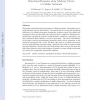CORR
2010
Springer
15 years 15 days ago
2010
Springer
This paper is the second part of a series of two papers dealing with bulking: a way to define quasi-order on cellular automata by comparing space-time diagrams up to rescaling. In...
101
click to vote
CORR
2010
Springer
15 years 15 days ago
2010
Springer
This paper studies directional dynamics in cellular automata, a formalism previously introduced by the third author. The central idea is to study the dynamical behaviour of a cell...
96
Voted
ADVCS
2007
15 years 16 days ago
2007
Cellular learning automata is a combination of learning automata and cellular automata. This model is superior to cellular learning automata because of its ability to learn and als...
108
click to vote
MCU
2004
15 years 1 months ago
2004
The classification of discrete dynamical systems that are computationally complete has recently drawn attention in light of Wolfram's "Principle of Computational Equivale...
117
Voted
JAC
2008
15 years 1 months ago
2008
In this paper, we study amalgamations of cellular automata (CA), i.e. ways of combining two CA by disjoint union. We show that for several families of CA obtained by simple amalgam...
110
Voted
JAC
2008
15 years 1 months ago
2008
This reading guide aims to provide the reader with an easy access to the study of universality in the field of cellular automata. To fulfill this goal, the approach taken here is o...
126
Voted
JAC
2008
15 years 1 months ago
2008
Cellular automata are a simple model of parallel computation. Many people wonder about the computing power of such a model. Following an idea of S. Wolfram [16], M. Cook [3] has pr...
124
click to vote
JAC
2008
15 years 1 months ago
2008
In this paper, we exhibit a strong relation between the sand automata configuration space and the cellular automata configuration space. This relation induces a compact topology f...
103
click to vote
DLT
2007
15 years 1 months ago
2007
Abstract. We study the dynamics of cellular automata, and more specifically their transitivity and expansivity, when the set of configurations is endowed with a shift-invariant (p...
111
Voted
BCS
2008
15 years 1 months ago
2008
We propose a defi nition of Cellular Automaton in which links between cells can change during the computation. This is done locally by each cell, which can reach the neighbours of...





